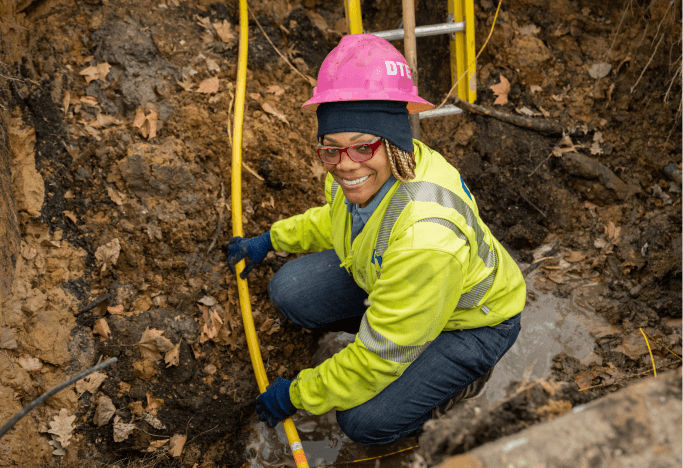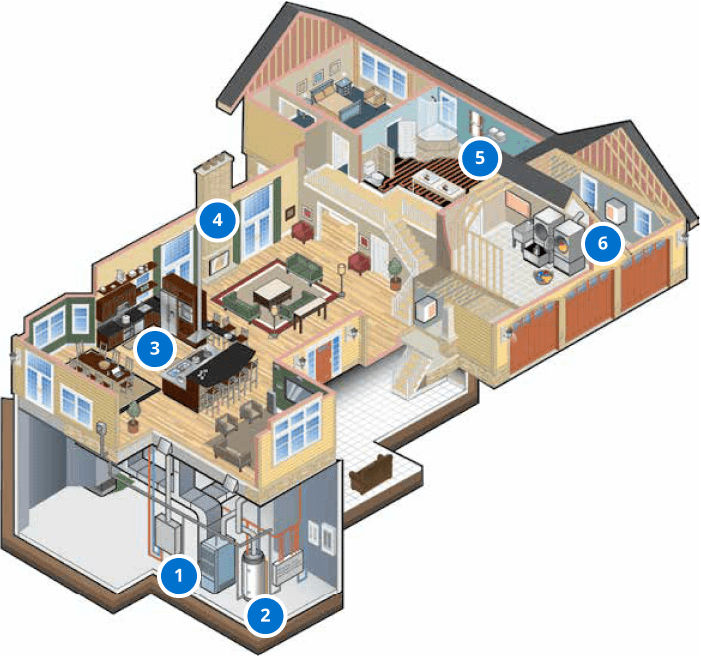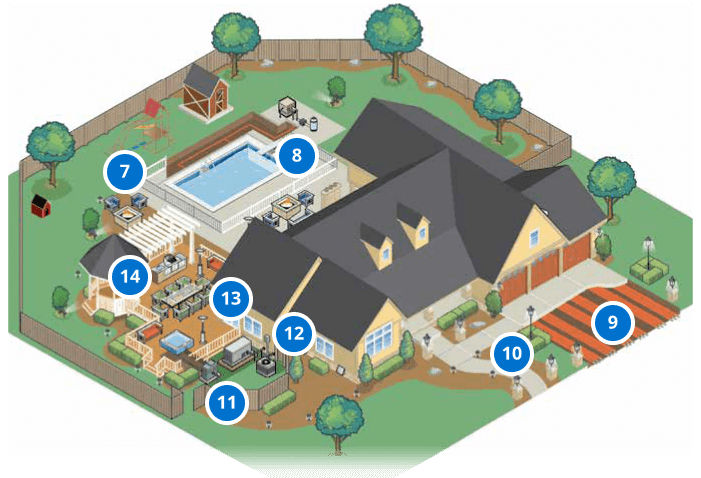Natural Gas For Your Home
Natural gas delivers value, reliability and convenience in many ways.
Natural gas provides many advantages for your home comfort and appliances and is a safe and abundant resource. You can also find ways that natural gas can save you money and suit your lifestyle on the natural gas home tour.
Preferred for Home Heating
Natural gas provides warmer air and heats a home faster than other fuel sources. High-efficiency or condensing natural gas furnaces typically last longer and have lower maintenance costs.
Plentiful Hot Water
Natural gas-fired tank water heaters are more energy efficient and use less water than electric models. Tankless water heaters are even more energy efficient and can save an average household hundreds of dollars per year on energy bills.
Precise Cooking Temperatures
When it comes to cooking, nine out of 10 professional chefs and 75 percent of homeowners say that natural gas stoves and ovens provide a superior cooking experience. Plus, natural gas outdoor grills have instant startup and flame controls, and they never run out of fuel.
A Cozy and Clean Fireplace
Natural gas fireplaces are convenient and clean, add ambiance and come in a wide variety of styles to complement any decor. They can help keep you warm and add value to your home.
Light Your Outdoor Space
Outdoor lighting powered by natural gas provides security and charm. With a flickering, soft glow, natural gas lights can create a warm and welcoming ambiance for your outdoor space.
Extend Pool & Spa Season
Natural gas pool and spa heaters bring water to a desired temperature quickly, are cost efficient and more reliable, require less maintenance and have longer life cycles than most other heating options.
Let it Snow
Using the same radiant heat technology that warms floors in a home, a natural gas snow-melting system below a driveway or sidewalk safely clears away snow and ice. You won’t need a snow blower or shovel.
Up to 50% Savings
Natural gas is more cost effective than alternative fuels, such as propane, saving homeowners up to 50 percent on energy bills.
No Refills Needed
Enjoy convenience and dependability. Natural gas is reliable, and you'll never need to refill your propane tank again.

Abundant and Affordable
Natural gas supplies are abundant and provide the best energy value. We purchase and store natural gas year-round, which helps protect you from sudden price spikes. As a result of our efforts, residential customers’ total natural gas bills have dropped nearly 30 percent over the last 10 years.

Safe
We are committed to the safe and reliable delivery of this vital energy resource to homes and businesses across Michigan. We follow rigorous safety practices in everything we do, and we are upgrading our natural gas infrastructure to keep our entire system safe.

Dependable
Natural gas is there when you need it to heat your home, cook your meals and warm your showers. Day in and day out, through every season, you can rely on DTE Gas for many of life's daily needs.

Made in the USA
Did you know that 85 percent of the natural gas consumed in this country is produced right here in the United States? DTE delivers clean, homegrown and affordable energy as well as economic growth and employment opportunities in Michigan.
- 1
- 2
- 3
- 4
Natural Gas For Your Home
Explore natural gas uses in and around your home.
Find ways that natural gas can save you money and suit your lifestyle with convenience and comfort in many ways.

Indoor Living with Natural Gas
Natural gas appliances can keep your home comfortably warm when the weather turns cold.
High-efficiency natural gas furnace
- Warms homes quicker than other fuel sources
- Reduces energy bills up to 15% compared to standard efficiency units
- Reaches efficiency levels as high as 98%
- Provides up to 20 years of reliable service when well-maintained
High-efficiency natural gas boiler
- Heats water, not air, and circulates through plastic tubing, baseboards or radiators
- Is smaller in size to allow for more storage and save on energy bills
- Gives opportunity to use 10-40% less natural gas with high-efficiency models
- Heats water twice as fast as other fuels
- Offers to save even more money with ENERGY STAR models
- Is available in tankless models that heat water only when it’s needed at desired temperature - 25% more efficient; more than 20-year life expectancy
- Provides even heat and precise temperature controls
- Saves time – no waiting for burners to heat up or cool down
- Allows quick and easy cleaning with sealed burners
- Offers better energy efficiency than other fuel sources
- Ignites automatically and can be used even during a power outage
- Adds moisture to baked foods, making for better tasting meals
- Allows you to move your grilling inside to enjoy grilled food year-round
- Offers the same ambience and charm of wood without the work
- Turns instantly on or off with a switch or remote control
- Leaves no ashes to bag, no smoky smells, no chimney to clean
- Warms cold floors and surrounding air through tubing installed beneath the surface
- Eliminates cold spots by distributing heat evenly across the floor surface
- Is environmentally clean - no forced air to circulate dust or other particles
High-efficiency clothes dryers
- Reduces drying time by 50% - saves energy and time
- Dries two loads of laundry for the price of one
- Is gentler on clothes, reducing wrinkles and static cling

Outdoor Living with Natural Gas
- Offer easy on and off controls and cooking options are available
- Are durable and elegant, made to withstand the outdoors
- Provide beauty, warmth and ambiance to your outdoor living area
- Eliminate the need to chop or haul and no soot or ashes to clean up
Fireplace inserts
- Heat additional space with a fireplace insert
- Improve heating efficiency and reduce environmental impact
- Extend your outdoor swimming and spa seasons
- Create consistent, comfortable water temperature
- Are easy to install and affordable to operate
- Are compact, lightweight and durable - last for years
- Installed just below the driveway and sidewalk surface
- Sensors detect snow or ice to automatically activate the system and heat paved surfaces, preventing the need for a shovel or snow blower
- Provides a warm, glowing light to outdoor rooms, entryways, patios and decks
- Adds outdoor security during power outages
- Available in hanging, tabletop, pathway or pole styles - some torch styles add a tropical feel to any backyard
- Provide a healthier atmosphere inside a home and will help reduce energy bills
- Operate independently of the home’s heating and cooling system
- Combine with the overall indoor air-filtering system to reduce humidity levels
- Start up automatically and run continuously
- Extend your outdoor entertaining season
- Offer an easy push-button to turn on and adjust heat controls
- Provide comfortable, warm air for up to a 20-foot radius
- Are available in a variety of sizes, shapes and cooking surface areas
- Offer convenient, clean grilling and a continuous fuel supply
- Start up instantly with flame control to make grilling fast and easy
- Available in a variety of sizes, shapes and cooking surface areas
- Make connecting and disconnecting outdoor gas appliances safe, easy and convenient
- Are easy to add or move grills, patio heaters, fire pits and more
- Offer safety features that prevent use unless an appliance is correctly connected